Polar & Paleoclimate Modeling Group
We use climate models to provide insights into changes in the Arctic Ocean and its sea ice cover as well as into changes in the ocean in past climates. The focus of the group is currently is on assessing the role of internal variability versus forced changes in the Arctic Ocean, on process-based model assessment against observations, and on using isotopic tracers in the ocean to improve model-data comparisons and provide dynamical insights for paleoclimate.
- Nate Farmer, Undergraduate Research Assistant, 2022
- Daphne Quint, Undergraduate Research Assistant, 2022
- Rajan Patel, Undergraduate Research Assistant, 2022
- Patrick Ugrinow, Undergraduate Research Assistant, 2022
- Patricia DeRepentigny, PhD, 2021
- Hannah Zanowski, Postdoctoral Scholar, 2019-2021
- Abigail Smith, PhD, 2021
- Sara Jean Reinelt, Undergraduate Research Assistant
- Rory Laiho, Graduate Student Assistant
- Kerrie Dochen, Undergraduate Researcher
- Aaron Schroeder, Graduate Student Assistant
- Ivonne Martinez, Summer REU student, co-advised
- Yafang Zhong, Postdoctoral Research Associate, co-advised
Contact
Alexandra Jahn Phone: 303-735-3352
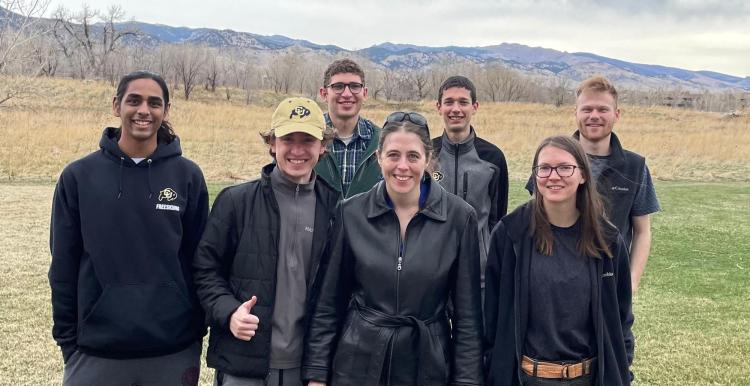
The Polar and Paleoclimate group in April 2022. From left, front row: Rajan Patel, Patrick Ugrinow, Alex Jahn, Daphne Quint. Back row, from left: Jed Lenetsky, Chris Wyburn Powell, Nate Farmer.
Blog headlines
- October 2022: Chris published his first lead-authored article, on Modeled Interannual Variability of Arctic Sea Ice Cover is within Observational Uncertainty.
- August 2022: Alexandra is on sabbatical at PIK and TU Berlin in Germany, from now till July 2023, as Alexander von Humboldt Fellow.
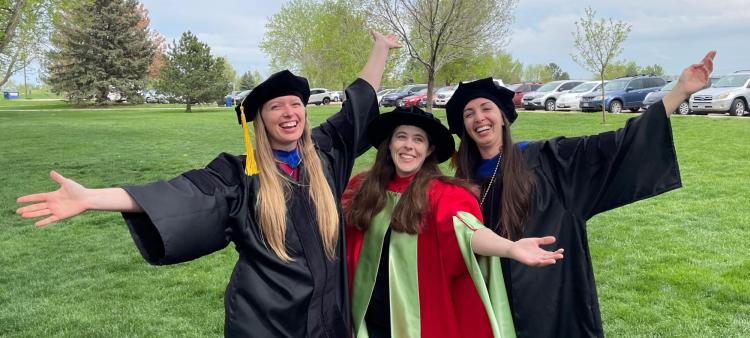
May 2021: Graduation - Abigail Smith, Alexandra Jahn, Patricia DeRepentigny
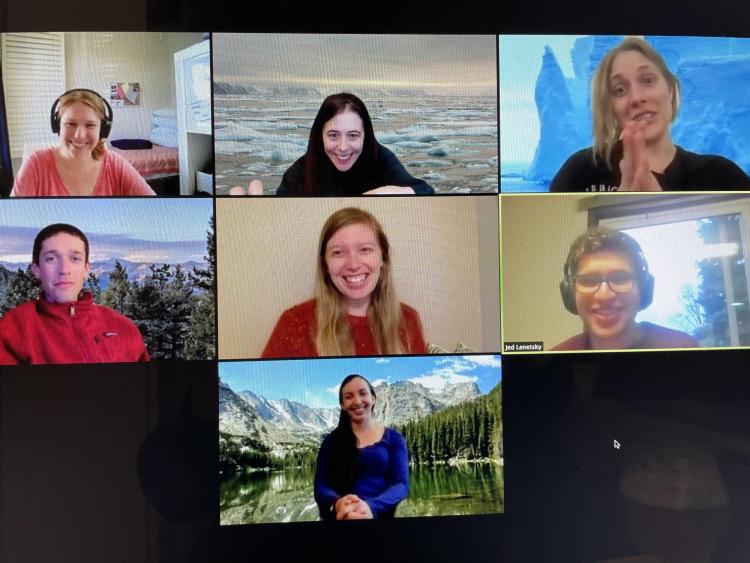
April 2021: Sara Reinelt, Alexandra Jahn, Hannah Zanowski, Chris Wyburn-Powell, Abigail Smith, Jed Lenetsky, Patricia DeRepentigny
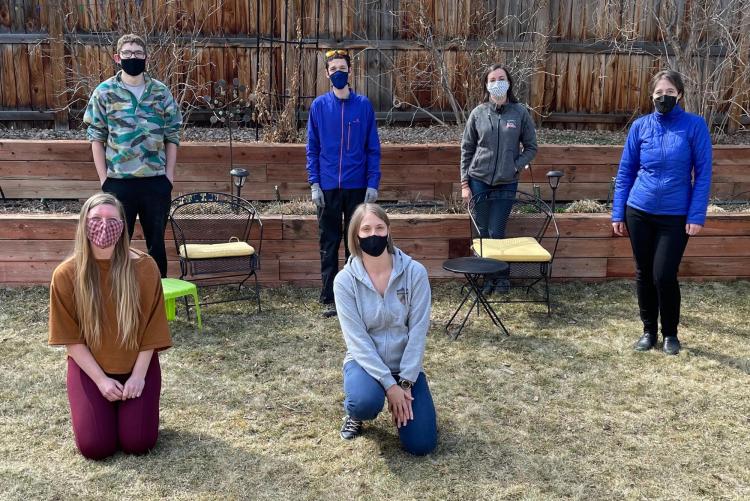
March 2021: Abigail Smith, Hannah Zanowski, Jed Lenetsky, Chris Wyburn-Powell, Patricia DeRepentigny, Alexandra Jahn
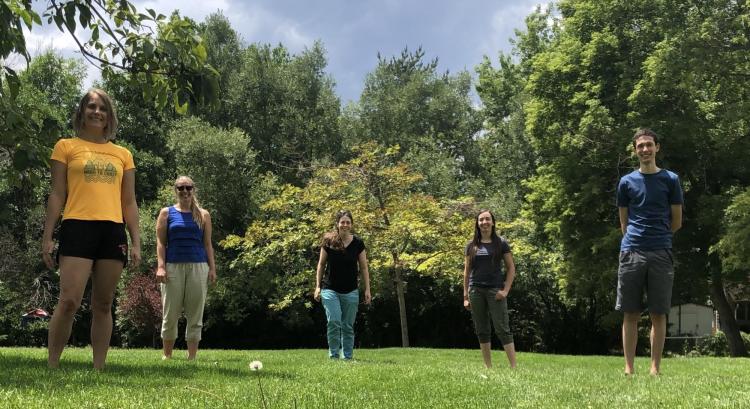
Summer 2020: Hannah Zanowski, Abigail Smith, Alexandra Jahn, Patricia DeRepentigny, Chris Wyburn-Powell
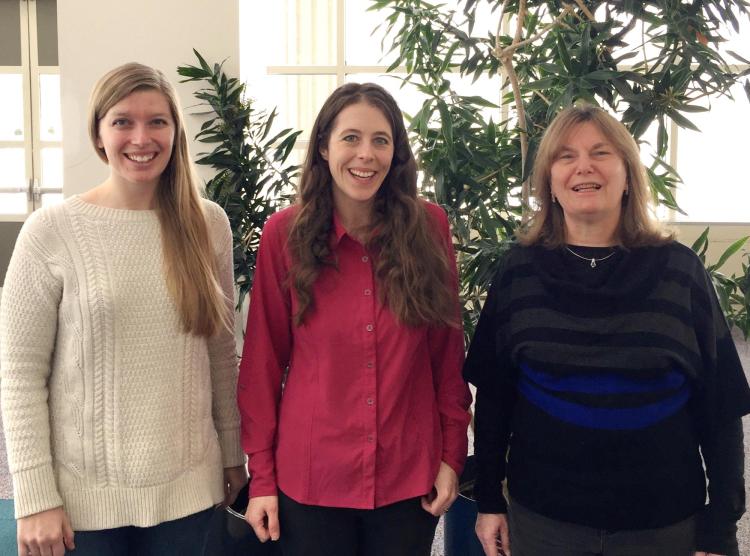
Spring 2016: Abigail Smith, Alexandra Jahn, Rory Laiho
Projects
In this NSF-funded project, we aim to provide insights into the role sea ice plays in the distribution of microplastics in the Arctic and globally. We are combining laboratory data and modeling to better understand the uptake of microplastics into sea ice and the effect on the microplastic distribution in the ocean and sea ice in the Arctic. Collaborators on this project include Mike Steele (UW), Maddie Smith (Woodhole), B. Light (UW), M. Orellana (UW), and D. Bailey (NCAR). We are looking for a postdoc who will work on the modeing side of the project, based at CU, with a start date in summer or fall 2023.
In this NSF-funded project, we aim to identify drivers of the model spread in the CMIP6 sea ice simulations, in order to ultimatly reduce Arctic sea ice projection uncertainty. This includes an assessment of thermodynamic and dynamic drivers of sea ice loss and improving the understanding of the contribution of internal variability to sea ice loss as well as its dynamic drivers. Group members who have contributed to this project are Alexandra Jahn, Chris Wyburn-Powell, Patricia DeRepentigny, Abigail Smith, Nathanael Farmer, Daphne Quint, Patrick Ugrinow and Rajan Patel. Details on the various sub-projects and the publiucations from this award can be found on the project website https://sites.google.com/colorado.edu/career-jahn.
In this NSF-funded project, we are using modeling and multi-proxy analyses of sediment cores from northern Baffin Bay to discover the timing and climatic consequences of the opening of the western gateway for Arctic freshwater to the Labrador Sea. For this project, we will perform mid-Holocene model simulations with the CESM to assess the impacts of the opening of the western freshwater route of the Arctic-Atlantic throughflow on the freshwater outflow to the North Atlantic, the watermass structure in Baffin Bay, and the formation of the North Water Polynia. Collaborators include Anne Jennings, Tom Marchitto, Lineke Woelder, John T. Andrews, and Hannah Zanowski (all INSTAAR).
In this NSF-funded project, we will perform model simulations to help assess the dynamical drivers of Davis Strait flux changes and their downstream impacts on the North Atlantic. Collaborators include Craig Lee (UW) and Paul Myers (Univ. of Alberta)
In this NSF-funded project, we will perform CESM simulations with neodynium isotopes to simulate the Eocene Southern Ocean circulation and compare the model results with neodynium isotope records from shark teeth. Collaborators include Sora Kim, Matthew Huber, and Howie Scher.
Completed projects
C-iTRACE: Isotope-enabled paleo ocean modeling for the deglacial
In this NSF-funded project, we are using recenty developed carbon, water, neodynium, and Pa/Th isotopes within the CESM ocean model to assess the simulated deglacial climate evolution against proxy records and isotope observations. Collaborators include Zhengyu Liu (The Ohio State University), Sifan Gu (Shanghai Jiao Tong University), Bette Otto-Blienser (NCAR), Hannah Zanowski (CU), and Sara Reinelt (CU). Project website: https://sites.google.com/colorado.edu/citrace. CiTRACE output is available at https://doi.org/10.5065/hanq-bn92.
Assessing the simulated Arctic freshwater system in CMIP5 Models, the CESM Large Ensemble, and forced simulations
In this NSF-funded project, we worked to assess various aspects of the the Arctic freshwater budget, including simulated by CMIP6 climate models (Zanowski et al., 2021), changes in freshwater pathways on various timescales (Otto-Bliesner et al. 2017, DeRepentigny et al. 2020), and the influence of internal variability on the simulated Arctic freshwater budget (Jahn and Laiho, 2019) and Arctic sea ice (England et al., 2019), as well as on the predictability of an ice-free Arctic (Jahn et al. 2016, Jahn 2018). Collaborators on this project include Marika Holland (NCAR), Bruno Tremblay (Columbia University & McGill University), Rory Laiho (CU), Patricia DeRepentigny (CU), and Hannah Zanowski (CU). Timeseries of the Arctic freshwater terms from the CESM Large Ensemble and the CESM Low warming ensemble are archived at the NSF Arctic Dater Center (Jahn 2020) and CMIP6 model Arctic freshwater terms are also archived there (Zanowski and Jahn, 2021).
Understanding Arctic melt season changes through modeling
In this project funded through a NSF-GRF and NASA FINESST grant to Abigail Smith, we contributed to a better understanding the melt season changes in the Arctic Ocean. The first part of this project was focused on assessing the impact of definition choices and internal variability on melt season charcteristics. This work is published as Smith and Jahn (2019). A paper on useing melt season characteristics to provide an improved assessment of sea ice simulations from CMIP6 models in collaboration with M. Wang (UW) was published as Smith et al. (2020). As final step, Abigail Smith adapted a passive microwave sea ice emulator for the use in earth system models for melt onset in the CESM2, to better compare sea ice simulatons of melt onset from earth system models with satellite retrievals. This work was done in collaboration with Dirk Notz and Clara Burgard from the Max Plank Institute of Meoerology in Hamburg and is currently in prepartion for publication.
Climate of the past 2000 years: past2k CESM simulation
In this project, we performed a transient CESM model simulation for the last 2000 years, called past2k. In the analysis, we have focussed on the assessment of the drivers of the asymetric cooling rates of the Atlantic and Pacific Arctic. Collaborators on this project are Y. Zhong (University of Wisconsin Madison), G. Miller (INSTAAR) and A. Geirsdottir (Univ. of Iceland). Results are published in Zhong et al. 2018. Forcing data for the past2k simulation is published as Zhong et al. (2018). Outout from the past2k simulation is freely available at: https://www.earthsystemgrid.org/dataset/ucar.cgd.ccsm4.past2k_transient.html
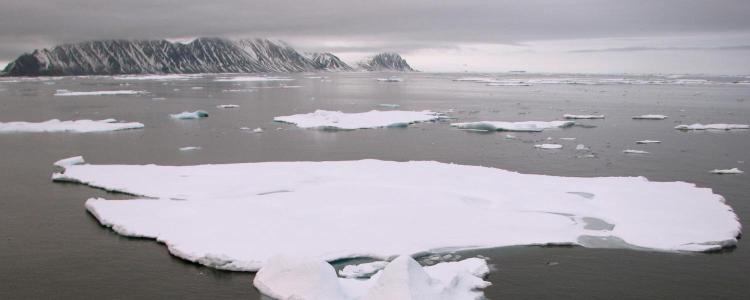
Sea ice in the ocean in northern Baffin Bay in September 2008. Credit: Alex Jahn
Publications
Publications for Jahn are shown below




